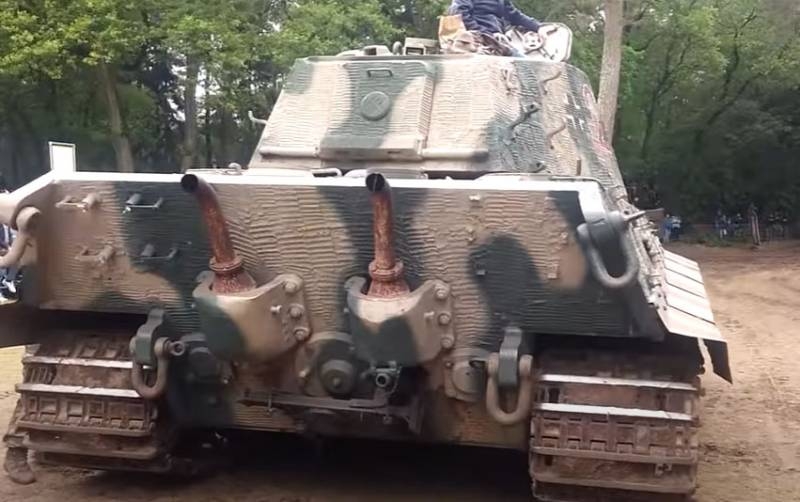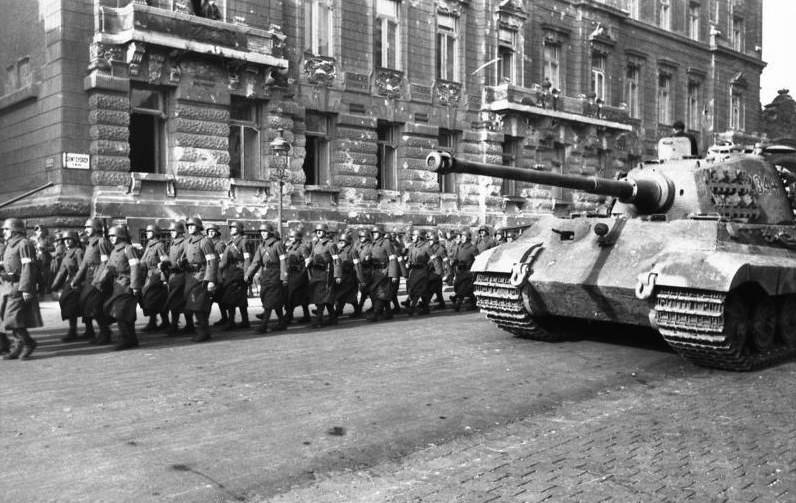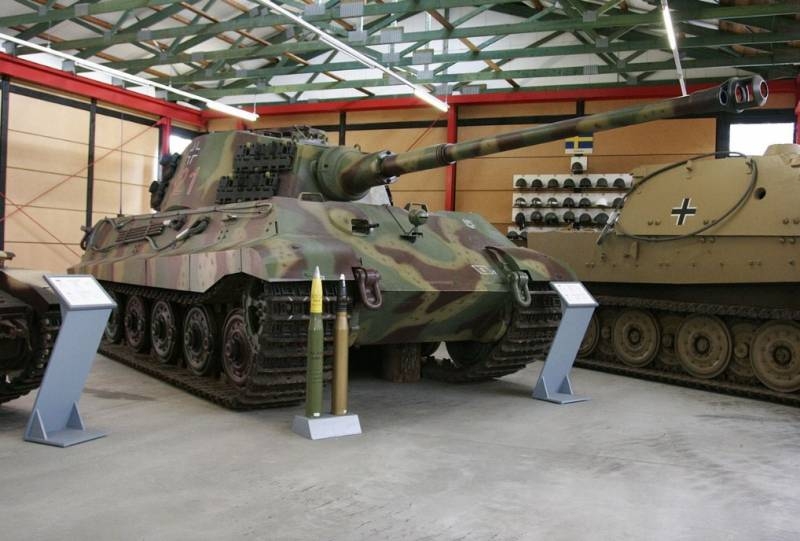
Polish author Jerzy Reszynski considers, what to confidently answer the question, which tank, fighter or bomber during the Second World War was the best, hardly possible. Nevertheless, very often the German "Tiger" is called the most efficient tank of that time, whose full name is Panzerkampfwagen VI Ausf. B Tiger II.
The heavy tank of the final period of the war was produced in 1943-1945 gg., and was in service with the Wehrmacht in 1944-1945 gg. As you can see, to turn the tide of the war "Tigers" have failed. But this does not detract from the strengths of the tank., favorably distinguishing the German vehicle from the Allied tanks.
Pros and cons of Tiger II
The main advantages of the "Tiger" – powerful 88 mm cannon, which made it possible to hit all the tanks of the anti-Hitler coalition at fairly long distances in 2,5 km, as well as strong armor, the sheets of which were located at rational angles of inclination and well protected the tank from most of the enemy's anti-tank guns.
At that time, the German tank building industry could not create a power plant., suitable for such a heavy machine. Therefore, the tank used the Maybach HL engine. 230 P30 power 700 hp, which also operated the lighter Tiger and Panzerkampfwagen V Panther tanks.
Mass production of the tank in question began in 1944 year. By this time, the situation on the fronts was clearly not in favor of Germany., and the German military industry experienced an increasing deficit as well as raw materials, and qualified personnel. As a result, we managed to release less 500 vehicles of this type - a drop in the bucket compared to the total number of tanks, who took part in the battles of World War II. The extremely complex technology was also a serious obstacle to the mass production of "Tigers", inconsistent with the economic realities of wartime. The complexity in production and maintenance was the first noticeable disadvantage of the legendary tank..
Another unconditional disadvantage was the discrepancy between the engine power and the weight of the tank.. Tank "Tiger" weighed more than 70 tons with engine in 700 hp, whereas, for example, modern tank Abrams weighs over 60 tons with engine power 1500 HP. T-72 – weighs 41 ton, but with drive power 780 HP, K2 Black Panther весит 55 tons driven 1500 HP. obviously, that such a ratio of engine power and tank weight affected the speed of movement of the "Tiger" for the worse, significantly complicating its use in real combat conditions.

Jerzy Reszynski notes, that the Wehrmacht did not bother with the creation of special engineering companies as part of heavy tank battalions, which would provide very heavy vehicles with the ability to move. During the war, things were already very bad with roads and bridges.. The situation was not saved by the transfer of sapper companies to tank units.. As a result, there were such situations., when, while moving around cities and towns under the "Tigers", the underground infrastructure was destroyed, as a result of which huge cars were stuck in the ruins of the sewers.
Also tanks "Tiger 2" were completely helpless in the swampy area., especially after heavy rains. The German military industry no longer had the ability to develop and quickly produce technical machines., capable of evacuating a damaged 70-ton tank.
A victim of your own greatness
Eventually, as Jerzy Reszynski notes, tank "Tiger" has become a victim of its own greatness. In August 1944 of the year the tank made its debut on the Eastern Front. first division, fully armed with these tanks, was the 501st heavy tank battalion, formerly fought in Tunisia, North Africa. The illustrious unit was transferred to Poland, where the rapid offensive of the Red Army unfolded. However, the Tiger 2 tanks could not stop him..

At first, 15 new machines were out of order even when they were loaded onto railway platforms in Germany. Secondly, 10 tanks were damaged during the march towards the headquarters of the tank division. Nevertheless, German tanks managed to effectively oppose the Soviet troops, whose anti-tank guns were completely helpless in front of such heavy vehicles. This allowed the commander of the 501st Battalion, Major Erhard von Legat, to arrogantly declare, that it was not an attack, and "the hunt for Ivan".
But soon Soviet troops transferred their own units of heavy tanks with well-trained crews here., and then there was no longer the "hunt for Ivan", and the "hunt for Fritz". As a result, 3 "Tigers" were thrown by the crews in the area of Ogledovo. Now one of these vehicles is exhibited in the Armored Museum in Kubinka near Moscow.
Of course, Nazi propaganda tried to create the appearance of the huge performance of new tanks on the battlefield. But actually, everything was completely different, what did the henchmen of Joseph Goebbels portray. for example, in a skirmish near Lisovo, Soviet IS-2 tanks completely destroyed the "Tigers" battalion, who lost all his equipment and was evacuated from the battlefield.
Soviet military experts carefully studied all copies of the "Tiger 2" that fell into their hands.. As a result, the following conclusions were made about the shortcomings of the tank.: too much weight is recognized as the main disadvantage, maximally reduced the maneuverability of the tank. Besides, found out the presence of structural defects in the drive system, engine problems, difficulty in service.
To my surprise, Soviet specialists also established a decrease in the quality of armor: it has deteriorated significantly compared to earlier generations of Panther and Tiger tanks. The deterioration in the quality of armor was a direct consequence of the shortage of high-quality raw materials. Finally, the tank ran on gasoline, consuming huge amounts of expensive fuel.
Roughly the same conclusions, as Jerzy Reszynski notes, were made by the American military. The US Department of Defense did not understand, what considerations were the German engineers guided by, creating this car. Polish author notes, that instead of the "royal Tiger" it turned out to be clumsy, troubled colossus. His weaknesses were quickly revealed not only at the front., but even when transferred to it.
Author:Ilya Polonsky
used photos:Bundesarchiv, Wikipedia / baku13











